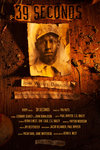



John Wesley Donaldson may be the greatest American baseball player you’ve never heard of.
Born in 1892 in the tiny town of Glasgow, Mo., the young African American ball player went on to become a pitching sensation in the Negro Leagues and beyond. His active baseball career spanned more than three decades.
Longfellow film maker Paul Irmiter took a deep dive into this little known story three years ago. When he learned of Donaldson’s athleticism and prowess on the baseball field, coupled with the courage he showed in facing the unrelenting racism of the Jim Crow era, Irmiter was intrigued.
He wondered, “How is it that John Donaldson’s story has never been told? How could an athlete of such distinction end up buried in an unmarked grave?”
Irmiter recently finished a feature length documentary about Donaldson. The film premiered at the Riverview Theatre on July 29, 2021. “39 Seconds” will be screened again at the 2021 Twin Cities Film Festival in October, and at the Capri Theater in north Minneapolis later this fall.
Irmiter said, “From the outset, I knew this story had to be told. I was fortunate to be able to partner with some of the Twin Cities’ most experienced Black actors, producers, and crew. I got to be the director, but I couldn’t have done any part of the film without our team. One of the best things that came out of this project was these new, strong relationships.”
The “39 Seconds” team included Leonard Searcy in the title role, narrator Payton Woodson, line producer Bianca Rhodes, assistant director/voice director Kevin D. West, with casting by Sha’Cage and E.G. Bailey.
Rewind the reel of time
Donaldson had a long, successful career in baseball. Between 1912-1924, he pitched for nine different teams across the country. He averaged 20 strike outs per game as a star pitcher for J.L. Wilkinson’s multi-racial All Nations team from 1913-1917. New York Giants’ manager John McGraw assessed Donaldson’s value at $50,000 – if he had been White.
During the summer of 1924, Donaldson’s career took a new turn. He started barnstorming across the Midwest with semi-independent Black teams, playing against White semi-pro ball clubs. Some of the games were played in small Minnesota towns: places like Bertha, Lismore, St. Cloud, and Fergus Falls.
As Irmiter said, “It’s impossible to over-estimate what baseball meant to America in the early and mid-20th century. In big cities and small towns, there was nothing else like it.”
On a warm summer’s night
At a game played in Fergus Falls in the summer of 1924, a fan stood in the grass with a hand held movie camera. He shot 39 seconds of film that captured Donaldson on the pitcher’s mound. It is the only known footage of Donaldson in action, serving up a rapid-fire series of pitches with pinpoint accuracy.
Decades later, Richard Oxley of White Bear Lake found the silent, black-and-white film reel in his grandfather’s house in Fergus Falls – and gave it to Irmiter.
A string of connections
Irmiter was immediately drawn into the story of John Donaldson, but wrestled with how to tell it. He said, “I was waiting for my kids in the South High School parking lot a few weeks later. I scrolled through some social media posts, and noticed one from local actor Leonard Searcy. When I saw his face, I thought, he’d make a great John Donaldson.”
Searcy agreed to play the role of John Donaldson, and introduced Irmiter to Kevin D. West, general manager of the Capri Theater in North Minneapolis. The web of connections was starting to grow. Immersed in the world of theater and theater people, Irmiter decided to interweave elements of theater and storytelling into his documentary film.
All of the live action scenes were filmed in October of 2018 at Gremlin Theatre in St. Paul.
Irmiter said, “We started this project before COVID-19 hit. Weirdly, the pandemic gave me the time and space to finish it. I had to clear everyone out of the studio, and all my work in advertising crashed. I was able to spend time downloading a lot of photos from Donaldson’s era, including all the pictures and articles I could find on Donaldson himself. I printed them on paper that looks and feels like newspaper, and figured out an aging process for the paper by immersing it in coffee, among other things.”
By March of 2021, Irmiter said, “The bones of the film were all in place. We had 350+ Kicskstarter supporters who raised more than $30,000. People were taping money to my door, along with notes of encouragement to get this story told.”
How the story ends
After his long career in baseball ended, Donaldson moved to Chicago and worked various jobs, including five years as a scout for the Chicago White Sox (breaking the color barrier as a scout) and as a clerk for the U.S. Post Office. He died in 1970 at age 79 and was buried in an unmarked grave in Chicago’s Burr Oak Cemetery, where many other notable African Americans have been laid to rest.
In 2004, money for a headstone for Donaldson was raised in collaboration with the Negro League’s Baseball Grave Marker Project. This project has placed over 50 grave markers on previously unmarked graves for players of the Negro Leagues – to honor their contributions to history and the game of baseball.
And how it begins again
Irmiter said, “When we had the July 29 premiere at the Riverview, I wanted to say thank you to everyone who had worked on this project. It turned out, I was so nervous that I had to leave the theater right after the film started to run. I drove to my studio a few blocks away, swept the floors and bit my nails. I returned to the theater just in time for the closing credits, and invited the cast and crew to come up on the stage. There were so many of us, we filled it – and the theater responded with a standing ovation.”
In the end, the only thing that matters is, “Does the audience connect with the film?”
Find more information about future screenings of “39 Seconds” at www.39secondsfilm.com.